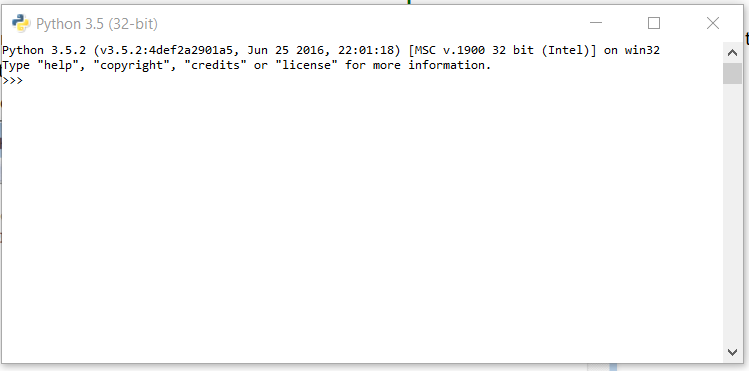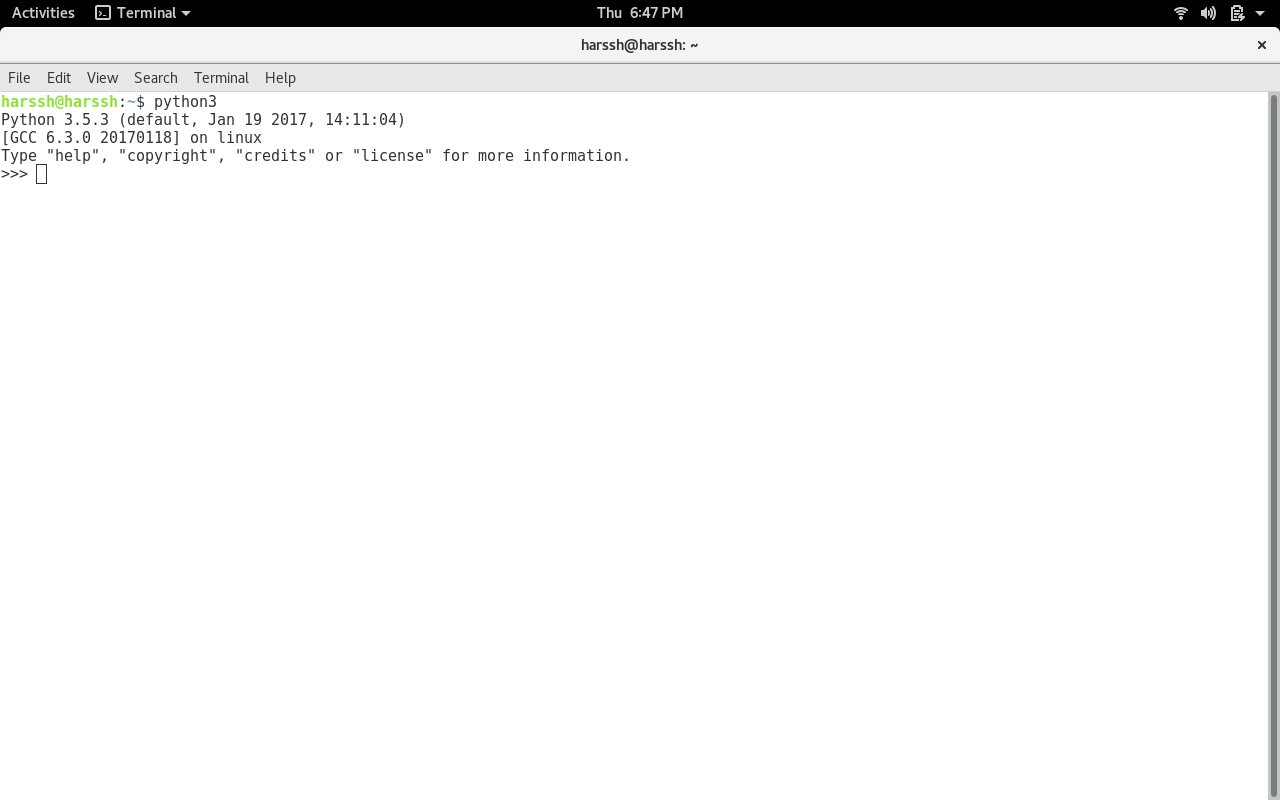python由Guido van Rossum于1990年代初期开发, 最新版本为3.7.1, 我们可以简单地将其称为Python3。 Python 3.0于2008年发布。它是一种解释语言, 即未编译, 解释器将逐行检查代码。本文可以用来学习以下方面的基础知识Python程序设计语言.
因此, 在继续之前..让我们做最流行的” HelloWorld”传统hence, 然后将Python的语法与C, C++, Java进行比较(之所以选择这三种语言, 是因为它们是最著名和最常用的语言)。
# Python code for "Hello World"
# nothing else to type...see how simple is the syntax.
print ( "Hello World" )注意:
请注意, Python的范围不取决于括号({}), 而是使用缩进作为范围。
现在继续前进
让我们开始我们的Python基础
。我将在一些小节中介绍基础知识。只要仔细阅读它们, 并相信我, 你将非常轻松地学习Python的基础知识。
简介和设置
如果你在
Windows操作系统
下载Python
点击这里
然后从安装程序安装, 并在开始菜单中输入IDLE.IDLE, 你可以将其视为运行Python脚本的Python IDE。
看起来会这样:

如果你在
类似于Linux/Unix
只需打开终端并在99%的Linux操作系统上预安装Python操作系统即可。只需在终端中键入” python3″, 即可开始使用。
它看起来像这样:

” >>>”表示python shell及其准备好接受python命令和代码的地方。
变量和数据结构
在其他编程语言(例如C, C++和Java)中, 你需要声明变量的类型, 但在Python中, 你不需要这样做。只需键入变量, 并在将其赋值时, 它将自动知道给定的值是int, float还是char甚至是String。
# Python program to declare variables
myNumber = 3
print (myNumber)
myNumber2 = 4.5
print (myNumber2)
myNumber = "helloworld"
print (myNumber)输出如下:
3
4.5
helloworld看, 它有多简单, 只需创建一个变量并为其分配所需的任何值, 然后使用打印功能即可将其打印出来。 Python有4种类型的内置数据结构, 即list, 字典, tuple和设置。
list
是python中最基本的数据结构。列表是一种可变的数据结构, 即可以在创建列表之后稍后将项目添加到列表。就像你要在当地市场购物并列出了一些商品的清单一样, 以后你可以将越来越多的商品添加到清单中。
append()函数用于将数据添加到列表中。
# Python program to illustrate a list
# creates a empty list
nums = []
# appending data in list
nums.append( 21 )
nums.append( 40.5 )
nums.append( "String" )
print (nums)输出如下:
[21, 40.5, String]评论:
# is used for single line comment in Python
""" this is a comment """ is used for multi line comments输入输出
在本节中, 我们将学习如何从用户那里获取输入, 从而进行操作或仅显示它。 input()函数用于接收用户的输入。
# Python program to illustrate
# getting input from user
name = input ( "Enter your name: " )
# user entered the name 'harssh'
print ( "hello" , name)输出如下:
hello harssh# Python3 program to get input from user
# accepting integer from the user
# the return type of input() function is string , # so we need to convert the input to integer
num1 = int ( input ( "Enter num1: " ))
num2 = int ( input ( "Enter num2: " ))
num3 = num1 * num2
print ( "Product is: " , num3)输出如下:
Enter num1: 8 Enter num2: 6 ('Product is: ', 48)选拔
使用两个关键字” if”和” elif”以及else(elseif)在Python中进行选择
# Python program to illustrate
# selection statement
num1 = 34
if (num1> 12 ):
print ( "Num1 is good" )
elif (num1> 35 ):
print ( "Num2 is not gooooo...." )
else :
print ( "Num2 is great" )输出如下:
Num1 is good函数
你可以将函数想像成一堆旨在在整个Python脚本中完成特定任务的代码。 Python使用关键字” def”来定义函数。
语法如下:
def function-name(arguments):
#function body# Python program to illustrate
# functions
def hello():
print ( "hello" )
print ( "hello again" )
hello()
# calling function
hello()输出如下:
hello
hello again
hello
hello again现在我们知道任何程序都从” main”函数开始……让我们像许多其他编程语言一样创建main函数。
# Python program to illustrate
# function with main
def getInteger():
result = int ( input ( "Enter integer: " ))
return result
def Main():
print ( "Started" )
# calling the getInteger function and
# storing its returned value in the output variable
output = getInteger()
print (output)
# now we are required to tell Python
# for 'Main' function existence
if __name__ = = "__main__" :
Main()输出如下:
Started
Enter integer: 5迭代(循环)
顾名思义, 它要求一次又一次地重复。我们将在此处使用最流行的” for”循环。
# Python program to illustrate
# a simple for loop
for step in range ( 5 ):
print (step)输出如下:
0
1
2
3
4模组
Python具有非常丰富的模块库, 该库具有用于执行许多任务的多种功能。你可以通过以下方式阅读有关Python标准库的更多信息:
点击这里
关键字” import”用于将特定的模块导入你的python代码。例如, 考虑以下程序。
# Python program to illustrate
# math module
import math
def Main():
num = float ( input ( "Enter a number: " ))
# fabs is used to get the absolute value of a decimal
num = math.fabs(num)
print (num)
if __name__ = = "__main__" :
Main()输出如下:
Enter a number: 85.0这些是Python编程语言的一些最基础知识, 在以后的文章中, 我将同时介绍中级和高级Python主题。
如果发现任何不正确的地方, 或者想分享有关上述主题的更多信息, 请写评论。
首先, 你的面试准备可通过以下方式增强你的数据结构概念:Python DS课程。
 srcmini
srcmini
评论前必须登录!
注册